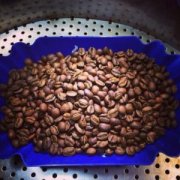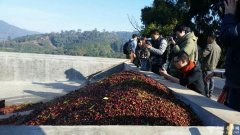A brief introduction to the treatment method of grinding degree and roasting degree of fine coffee in Ethiopian coffee manor

Yirgachefe coffee--
This kind of coffee grows in areas ranging from 1500 to 2200 meters above sea level. This coffee is washed in a clear stream, carefully selected by hand and exposed to plenty of sunshine. The taste is unique; the fruit is medium-sized, comparable to Mocha. The taste is mellow, the charm is unique, it gives people a fresh feeling, and the market prospect is optimistic. It is estimated that out of 42000 hectares of cultivated area, the average annual production of this coffee is 28000 tons (equivalent to 470000 bags of 60 kg coffee).
Sidamo Coffee-
This coffee grows in areas ranging from 1400 to 2200 meters above sea level on the shoulder slopes of the Rift Valley in East Africa. Natural (sun-cured) and washed coffee are of unique quality, moderate pH and good quality. It is estimated that out of 61000 hectares of cultivated area, the average annual production of this coffee is 37000 tons (equivalent to 620000 bags of 60 kg coffee).
In February 1977, Lieutenant Colonel Mengistu Haier Maryam (MENGISTU HAILE MARIAM) launched a military coup and served as Chairman and head of State of the interim military Administrative Council. In 1979, the Ethiopian Labor people's Party Organizing Committee, mainly composed of soldiers, was established to implement an one-party system. In 1984, the Ethiopian Workers' Party was formed according to the Soviet Communist Party model. In September 1987, Mengistu announced the dissolution of the "interim military Administrative Council", the end of military rule, the establishment of the "people's Democratic Republic of Ethiopia" and the establishment of a new parliament. Mengistu served as President and head of Government in December 1994. formulate the Constitution of the Federal Democratic Republic of Ethiopia. According to the Constitution, Ethiopia will implement a federal system and a parliamentary cabinet system after the general election for a term of five years. After the national election in May 1995, the Federal Democratic Republic of Ethiopia was established on August 22, and Meles became prime minister in her capacity as chairman of the majority party of the people's House of Representatives. On May 14, 2000, Ethiopia held a national election, and EGF defeated other opposition parties by an absolute majority to stay in power. In October, the new federal parliament and government were established, and the speakers of both houses and Prime Minister Meles were re-elected, and the original cabinet also remained in office with the approval of the parliament. In October 2001, May readjusted government institutions and reshuffled the cabinet, adding the Ministry of Youth, Sports and Culture and the Ministry of Taxation, and setting up a new cabinet composed of 18 ministers. In the fifties and sixties of this century, many African countries became independent one after another and adopted green, yellow and red as their national flags, so they were called "Pan-African colors." Ethiopia is one of the ancient countries in Africa, with a long history of more than 3000 years, giving green, yellow and red colors deeper roots in this land. Historically, they are closely related to the liturgy of the Coptic church, and are worshipped as the symbol of the trinity of the Father, the son and the Holy Spirit, reflecting the three virtues of loyalty, hope and kindness advocated by human freedom. These three colors also represent three regions of Ethiopia: Tikleh (red), Amhara (yellow) and Theo (green). Green represents fertile land, mild climate and rich plant resources, but also symbolizes hope for the future; yellow symbolizes peace and fraternity, as well as the people's determination to build the country; red symbolizes that the people are ready to shed blood and sacrifice to defend the motherland.
A large amount of coffee production (95%) is done by small shareholders, with an average yield of 561 kg per hectare. For centuries, minority holders of Ethiopian coffee farms have been producing a variety of high-quality types of coffee. The secret to producing high-quality coffee is that coffee growers have developed a coffee culture in a suitable environment through generations of repeated learning about the coffee growing process, which mainly includes farming methods using natural fertilizers, picking the reddest and fully ripe fruits and processing the fruits in a clean environment. The differences in the quality, natural characteristics and types of Ethiopian coffee all stem from differences in "altitude", "region", "location" and even land types. Ethiopian coffee beans are unique due to their natural characteristics, including "size", "shape", "acidity", "quality", "flavor" and "flavor". These characteristics give Ethiopian coffee a unique natural quality. usually, Ethiopia is always used as a "coffee supermarket" for customers to choose the kind of coffee they like.
Ethiopia produces between 200000 and 250000 tons of coffee each year. Today, Ethiopia has become one of the largest coffee producers in the world, ranking 14th in the world; the fourth largest coffee-growing villages in Africa account for about 35% of the country's total coffee production. These coffee farms, which use a multi-tier coffee planting system, are carefully cared for. Coffee farmers do not use chemical fertilizers, but use fallen leaves and animal and plant debris to increase soil nutrition. In addition to coffee, farmers also frequently grow non-coffee crops. Even manor coffee (coffee produced by state-owned farms), which accounts for 5% of the country's total coffee production, shows the characteristics of forest coffee production.
Located in the most advantaged natural conditions, Ethiopia produces unique high-quality coffee every year. Ethiopia's coffee growing cycle brings the joy of harvest to the country every year. Beautiful white coffee flowers will bloom and bear fruit every year from March to April. Only the reddest and ripe fruits are selected as coffee ingredients between September and about December. Exports of new coffee start in November or December each year-the coffee grows in areas ranging from 1400 to 1800 meters above sea level. This kind of coffee is natural or sun-cured; it is weakly moderately acidic, the fruit is full, and the average quality is good; the smell is fragrant and mellow; one drop in the mouth, endless aftertaste. It is estimated that out of 127000 hectares of cultivated area, the average annual production of this coffee is 70000 tons (equivalent to 1.17 million bags of 60 kg coffee).
Important Notice :
前街咖啡 FrontStreet Coffee has moved to new addredd:
FrontStreet Coffee Address: 315,Donghua East Road,GuangZhou
Tel:020 38364473
- Prev

A brief introduction to the planting climate and altitude of varieties in the coffee plantation of Ethiopia with full fruit
Located in the most advantaged natural conditions, Ethiopia produces unique high-quality coffee every year. Ethiopia's coffee growing cycle brings the joy of harvest to the country every year. Beautiful white coffee flowers will bloom and bear fruit every year from March to April. Only the reddest and ripe fruits will be selected between September and December.
- Next

A brief introduction to the market price of coffee cultivation in Ethiopian coffee farms with moderate acidity and alkalinity
Ethiopia produces between 200000 and 250000 tons of coffee each year. Today, Ethiopia has become one of the largest coffee producers in the world, ranking 14th in the world; the fourth largest coffee-growing villages in Africa account for about 35% of the country's total coffee production. These coffee farms, which use a multi-layer coffee planting system, get
Related
- Does Rose Summer choose Blue, Green or Red? Detailed explanation of Rose Summer Coffee plots and Classification in Panamanian Jade Manor
- What is the difference between the origin, producing area, processing plant, cooperative and manor of coffee beans?
- How fine does the espresso powder fit? how to grind the espresso?
- Sca coffee roasting degree color card coffee roasting degree 8 roasting color values what do you mean?
- The practice of lattes: how to make lattes at home
- Introduction to Indonesian Fine Coffee beans-- Java Coffee producing area of Indonesian Arabica Coffee
- How much will the flavor of light and medium roasted rose summer be expressed? What baking level is rose summer suitable for?
- Introduction to the characteristics of washing, sun-drying or wet-planing coffee commonly used in Mantenin, Indonesia
- Price characteristics of Arabica Coffee Bean Starbucks introduction to Manning Coffee Bean Taste producing area Variety Manor
- What is the authentic Yega flavor? What are the flavor characteristics of the really excellent Yejasuffi coffee beans?

